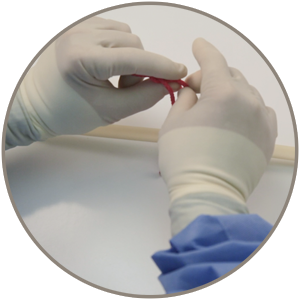Introduction to Hand Tie Techniques
In this topic, you will learn how to perform hand ties to create knots. Hand ties can be accomplished using either a one-handed or two-handed technique. As you will learn, each technique has some advantages and drawbacks that can influence how and when the hand tie is used during surgery. Additionally, over time, surgeons often develop a preference for using one technique over the other. The novice surgeon should concentrate on mastering at least one of the hand-tie techniques presented in this module.
Two-handed technique

![]()
Pros:
- Easy to learn
- Can be performed comfortably with shorter suture strands
- Easier to maintain consistent tension yielding a more reliable knot
![]()
Cons:
- May require more space to form a knot than the one-hand technique
![]()
Applications:
- Used when a secure knot is critical such as the end of continuous lines in the body wall and ligations
During the two-handed technique, the surgeon handles both ends of the suture strand to form the knot, and both hands are actively involved in knot formation. The main advantage of the two-handed tie is that the surgeon can readily apply continuous and equal horizontal tension to the suture ends until a secure knot is formed. This allows the creation of a more reliable square knot. The two-handed technique also tends to be easier for the novice surgeon to learn in comparison to the one-handed technique.
Click the video to watch a demonstration of the two-handed technique.
One-handed technique

![]()
Pros:
- Useful when tying in restricted areas; once mastered, can be a very efficient means of knot tying
![]()
Cons:
- More difficult to master than the two-hand technique
- Uneven tension with tendency to create half hitch
- Requires longer suture strands to control suture during knotting
![]()
Applications:
- Within body cavities, general knot tying
During the one-handed technique, the surgeon grasps and manipulates the suture strand using either the right or left hand. Only one hand is actively involved with knot formation. With the one-handed method, it is often difficult to maintain equal tension on the suture ends during the formation of the knot. Consequently, slippage (i.e., half-hitching) of the first or second throws may occur, especially by the inexperienced surgeon. The one-handed tie also generally requires more suture material to comfortably tie a knot than the two-handed technique. However, the one-handed technique requires less arm motion during knot tying, so the tie can be completed in restricted areas.
Click the video to watch a demonstration of the one-handed technique.
Both one-handed and two-handed techniques are useful. We recommend that the novice surgeon first master the construction of square knots with two hands before attempting to master the one-handed technique.
